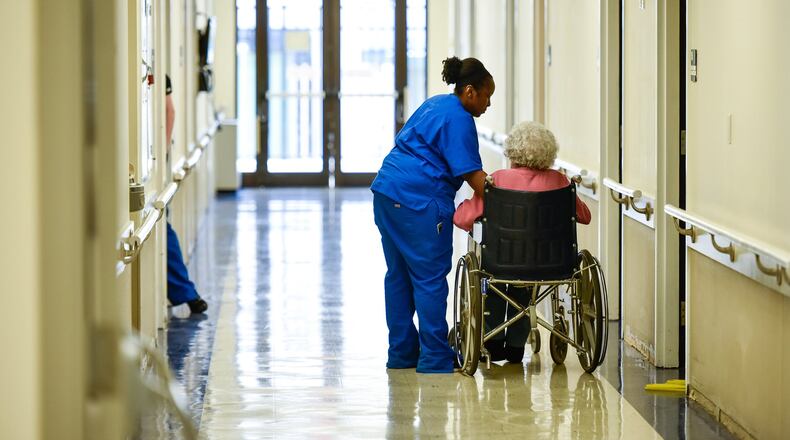“I expect we’ll have to move some more before the year is out,” Young said. “We’re just trying to work out how much that would end up being.”
RELATED: Butler County Care Facility finding niche in difficult industry
One year ago the facility needed a $425,000 subsidy and in 2016 the commissioners had to loan $225,000 to the nursing home so payroll could be met through the end of the year. This loan brings the Butler County Care Facility’s outstanding bill up to around $825,000.
At one time the county nursing home owed the general fund $1.1 million, a debt the home repaid partially but has continued to need regular infusions of cash as Medicaid rates, regulations and audits continually tinker with the bottom line. Care Facility Administrator Jennifer Strickland told the Journal-News mid-year it was nearly impossible to predict where the bottom line will land at year’s end, but she is estimated a deficit of $100,000 to $200,000.
The 109-bed facility is one of only about 25 county-run nursing homes — down from 34 in 2015 — left in Ohio. The nursing homes were mandated in all 88 counties when the first facility was built in 1830 to serve the infirm, poor and homeless. Many of the facilities closed after the state legislature lifted the mandate and counties opted to let the private sector handle nursing care as government budgets shrank.
Strickland told the commissioners during her budget hearing this week that the budget for 2019 is balanced at $5.8 million, which is six percent — or $370,000 — lower than 2018. The personnel at the facility has gone from 121 staffers in 2015, to 102 this year and a projected staff count of 88 next year.
She said one of her goals is to market the facility in the hopes of attracting a new clientele.
“We are going to increase our efforts in marketing and building strong relationships with both the community and local hospitals,” she said. “And put a major focus on innovative ways for the Care Facility to create a niche in the SNF (skilled nursing facility) market… Our biggest goal is to not have to borrow from the general fund.”
The average census for this year has been 89 patients — the national average is 81.7 percent occupancy — or 81.6 percent, but the in-house guests Monday totaled 92 or 82.5 Percent. So they have room to grow their population.
MORE: Butler County Care Facility working to repay $1.1 million debt
One niche they have already created are two segregated, male and female, secured dementia units — they are full — and officials believe those are one-of-kind in this market. Young said the nursing home industry as a whole is in a slump with census numbers — and thus revenues — falling off. He said until the “baby boomers” reach the age where they need these facilities, the trend will likely continue.
Just a few years ago, the county nursing home hadn’t a prayer to attract new clientele. It was a dark, foreboding place, with dingy paint, dark lighting, shabby furniture, malfunctioning equipment, structural challenges and other issues.
“It’s like a house that’s extremely well lived in,” Strickland said during a tour of the revamped facility.
Today the first two phases of the facility face-lift are just about complete — new roof, chiller, fresh cream-colored paint throughout, new ceiling tiles, lighting, flooring, furniture and redesigned spaces to create an open feel, to name a few improvements — and the final phase that includes a new $275,000 parking lot, generator, patio furniture — the outdoor patios are new too — and some odds and ends are all that’s left.
The commissioners have been diverting some Community Development Block Grant money — $400,464 since 2015 — away from other projects to the Care Facility. About $310,000 was pencilled in this year for the parking lot and other items, but those projects haven’t been tackled yet, according to Young.
Commissioner Don Dixon, who is in nursing home business, said the commissioners remain unwavering in their commitment to keep the home open, since it is often a place of last resort for residents. He said things are looking up, despite the need for a loan.
“We’re headed in the right direction…,” Dixon said. “They’re doing okay, they’re doing better than holding their own heading into ‘19, so we’ll continue to work at it, provide the service and hopefully we can get it to make a few dollars, worst case scenario breaking even is okay too.”
About the Author
